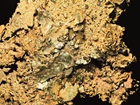| In conjunction with the ESM, "Stiftung Entwicklungsfonds Seltene Metalle" (Foundation for Rare Metals), Empa held a "Technology Briefing" on the topic of "Strategies for the sustainable use of critical materials" at the Empa Academy in Dübendorf. The event aimed to demonstrate ways in which industry and the research community can counter supply risks and the consequence of the ever greater use of these raw materials. As Patrick Wäger from the "Technology and Society" Department at Empa explained, raw materials/materials are regarded as critical when they are crucially important for the economy and society yet at the same time there is a relatively high supply risk. According to a study commissioned by the EU in 2014, the critical raw materials include a wide range of "rare" metals (meaning metals whose occurrence in the earth's crust is less than 0.01 per cent by weight), such as gallium, germanium, indium, cobalt, the platinum metals and the rare earth elements. The reasons for the high supply risk are the concentration of production of these raw materials in just a few countries, low recycling rates and poor substitutability.
Maren Liedtke from DERA, the German Mineral Resources Agency, addressed the issue of the raw materials supply cycle and pointed out that the capital decline in the mining sector and in processing in particular may lead to supply deficits in the medium term. Companies must therefore keep an eye on the markets and develop safeguarding and alternative strategies. She agreed with Wäger that the geological availability of these raw materials was not the main problem even given that demand was increasing. The increasingly negative ecological and social effects of the mining of raw materials are much more worrying. According to Wäger, the scientific community and industry should therefore redouble their efforts to use these raw materials in a more sustainable way. Possible approaches are substitution by non-critical raw materials, increasing material efficiency in production processes and products, and closing material cycles.
Possible solutions for industry
Margarete Hofmann, Managing Director of ESM, gave an overview of European activities in the field of critical metals and examined, based on these, possible measures for more sustainable use of critical raw materials in the areas of extraction, material efficiency and substitution. Important accompanying measures are the setting up of platforms for the exchange of information, training and further training and the analysis of strategies and systems, for example using material flow analyses and environmental life cycle assessments.
It is also clear to industry representatives such as Ute Liepold from Siemens, Jensen Verhelle from Umicore and Andreas Mai from Hexis, that their companies are dependent on critical materials and therefore it is necessary to adopt a more conscious approach in using them. According to Liepold, this includes substitution, a more economical use of materials and the recycling of production waste as well as reuse and the recycling of discarded consumer goods. With substitution however, the devil is in the detail, as is often the case, because many different factors such as product performance and quality, costs and energy input have to be taken into consideration. In addition, substitution requires "a long preparatory period" according to Liepold and therefore requires a lot of time. Verhelle demonstrated, using germanium as an example, how Umicore is already meeting much of its requirement through recycling.
Possible solutions from the field of research
One focus of the research into critical materials at Empa is the closure of material cycles such as with "urban mining", i.e. the recovery of raw materials from deposits created by man such as buildings or discarded consumer goods such as old electrical and electronic devices. Patrick Wäger presented ongoing products including the investigation being carried out in connection with the "revised Ordinance on the Return, Taking Back and Disposal of Electrical and Electronic Devices" (VREG) on the distribution of rare metals in electronic components in vehicles and fractions from the processing of used vehicles in car shredding facilities. At a European level, Empa, together with various research groups, has been involved since the start of the year as part of the "Horizon 2020" project, in the development of a database on the occurrence of critical raw materials in the European "urban mine". Susanne Rotter from TU Berlin, whose research group is also involved in the project, supported the idea that in future devices should increasingly be designed and produced with respect to their recyclability as well, i.e. it should be possible to recover rare metals from devices easily and with little time and expense. Currently, this is a complex, time-consuming procedure with many devices, with resultant high costs.
In order for companies to take action at all, however, they must first know which critical raw materials they use in their processes and products and what risks are associated within them. This is where a web tool developed by Ernst Basler + Partner and Empa researchers for small and medium-sized businesses comes in. Using this tool it is possible to evaluate the supply risks for more than 30 metals, the environmental and social impacts associated with their production and the susceptibility of the company to supply interruptions. The web tool will be available shortly on the swissmem website. | 
